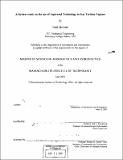A system study on the use of aspirated technology in gas turbine engines
Author(s)
McCabe, Niall, 1971-
DownloadFull printable version (7.346Mb)
Other Contributors
Massachusetts Institute of Technology. Dept. of Aeronautics and Astronautics.
Advisor
Jack L. Kerrebrock.
Terms of use
Metadata
Show full item recordAbstract
Increasing aircraft engine efficiency and reducing the engines weight have driven innovation in the aircraft engine business since its inception. By simply looking at the Brayton cycle increasing the compressor pressure ratio can bring about an increase in efficiency. To achieve this high pressure ratio, multi-stage axial compressors are used, which tend to be both heavy and expansive. Increasing the number of stages in an axial compressor can increase the pressure ratio and therefore the thermal efficiency; however as the number of stages increases, the engine weight, cost and length also increase, all of which are detrimental to the overall aircraft performance. Recent work by Kerrebrock, Merchant, and Schuler, has led to the possibility of achieving high pressure ratios with a reduction in the number of stages. These compressors use aspiration, or suction on the surface of the blades and endwalls, to keep the boundary layer attached over a greater percentage of the blade chord. Keeping the boundary layer attached longer allows the each blade row to be more highly loaded than the equivalent non-aspirated blade. This higher loading means fewer stages are needed to achieve a given pressure rise. The extracted air is brought inside the blade where it is removed at a convenient location. This bleed air can contain a substantial amount of energy that can be used for numerous purposes on the aircraft or engine. Recovery of the bleed flow and its disposition are important factors in the success of aspirated compressor technology. In this study it is assumed the bleed air can be used for threes purposes: its is returned to the turbine as cooling air, expanded overboard to augment the engine thrust or used to perform "auxiliary work" in a different part of the aircraft. The thermodynamic efficiency (as measured by the specific impulse) and the installed efficiency of the compression system were calculated for different engine/fan configurations and compared with equivalent non-aspirated engines. This allows the effects of aspiration to be quantified and can be used to assess if aspiration is viable for a specific setting.
Description
Thesis (S.M.)--Massachusetts Institute of Technology, Dept. of Aeronautics and Astronautics, 2001. Includes bibliographical references (p. 99).
Date issued
2001Department
Massachusetts Institute of Technology. Department of Aeronautics and AstronauticsPublisher
Massachusetts Institute of Technology
Keywords
Aeronautics and Astronautics.